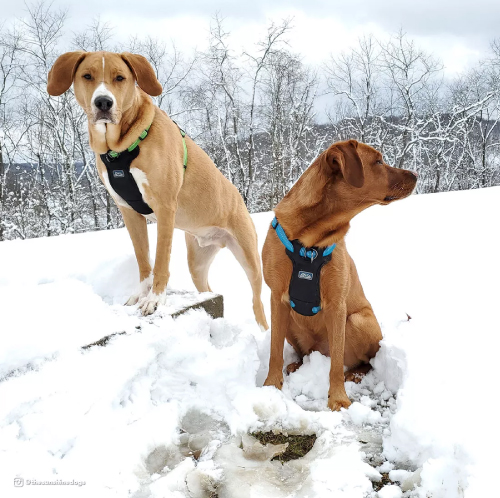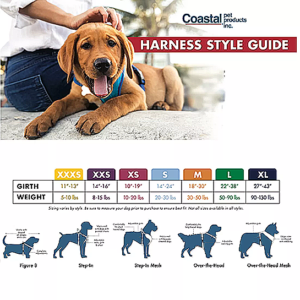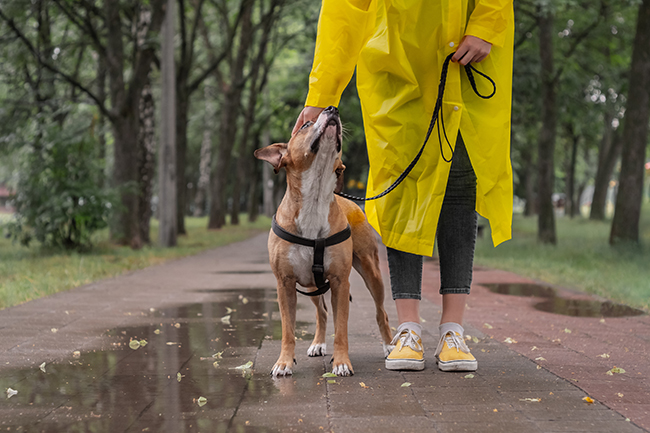By Coastal Pet Products Staff

A harness is not just another piece of gear for your clients’ dogs to sport while out on walks. Using a harness instead of a collar can provide added safety and benefits for a dog and their owner. Depending on harness type, they can provide owners with more control and assist with prevention of pulling. Properly sized harnesses are also less likely to slip off than a collar and do not put as much pressure on the neck and windpipe.
To ensure that a dog’s harness is working effectively for a dog and their owner, there are a few factors to consider.
Sizing
When it comes to dog harness sizing, the numbers owners need to know are girth and weight.
Owners need to pay attention to girth most importantly. Girth is the measurement around the broadest part of the dog’s chest (behind their front legs). Make sure the dog is standing up on all fours and wrap a flexible tape measure around the chest. The girth measurement will be used to determine the appropriate range of sizes for the dog.
 Weight comes second in determining which harness a dog needs. Once the owner knows the dog’s girth, they can use the dog’s weight to determine which size category the harness needs to be.
Weight comes second in determining which harness a dog needs. Once the owner knows the dog’s girth, they can use the dog’s weight to determine which size category the harness needs to be.
For example, with Coastal Pet harnesses, a dog with a girth of 30 inches could wear a medium, large, or extra-large harness depending on their weight. A 50-pound dog will wear a medium; a 75-pound dog will need a large; and a 100-pound dog will wear an extra-large.
To check that a harness is properly sized, owners should be able to fit two fingers between the harness and the dog’s body. There should not be any bunched skin around the dog’s neck or shoulders, or any indentations in the fur once removed.
To learn more about proper harness sizing, check out this video from Coastal Pet.
Types of Harnesses
There is a variety of harness types for different preferences or situations. Owners should consider their dog’s needs when selecting a harness.
Adjustable Strap
Adjustable strap harnesses (also known as figure 8 harnesses) are the most basic. These harnesses fit all kinds of dogs and can assist with easy walks, although they are not the best option for dogs who are heavy pullers.
These harnesses can be widely adjusted which is beneficial for puppies or dogs who are still growing.
Step-In Strap
A step-in harness is easier to get on a dog. It has two loops for each of the front legs and a back strap that clasps together with a leash attachment. These harnesses can be adjusted at the neck, girth, and chest.
A step-in harness helps owners have more control over their dogs, but it not recommended for strong pullers.
Step-In Padded/Mesh Vest
Padded harnesses are different because they have more material in the middle section. They can provide a little extra security for dogs due to the larger middle and are less likely to cause chafing.
Step-in padded vest harnesses are adjustable at the girth and are recommended for broader-chested dogs.
Over-the-Head Strap
Over-the-head harnesses are a type of figure 8 harness. They go over the dog’s head and then behind their legs. It clips together in the back.
Adjustable at the neck and girth, over-the-head strap harnesses are good for longer-haired dogs because they are less likely to snag on fur.
Over-the-Head Mesh Vest
This harness type also goes over the head, behind the legs, and clips in the back, however it has a larger middle section that is reinforced with webbing. This larger, reinforced middle helps spread pressure across a broader area when holding the dog back which protects their neck and windpipe.
This is a great option for dogs that pull.
Choosing the right harness can be a bit of a trial-and-error process for dog owners. It is most important to know the girth measurement and weight of the dog. After that, owners should evaluate their dog’s needs as well as their own needs when it comes to control, especially on walks. With a variety of harness types as well as colors and patterns, owners are sure to find something that fits their dog’s personality as well as their body.





